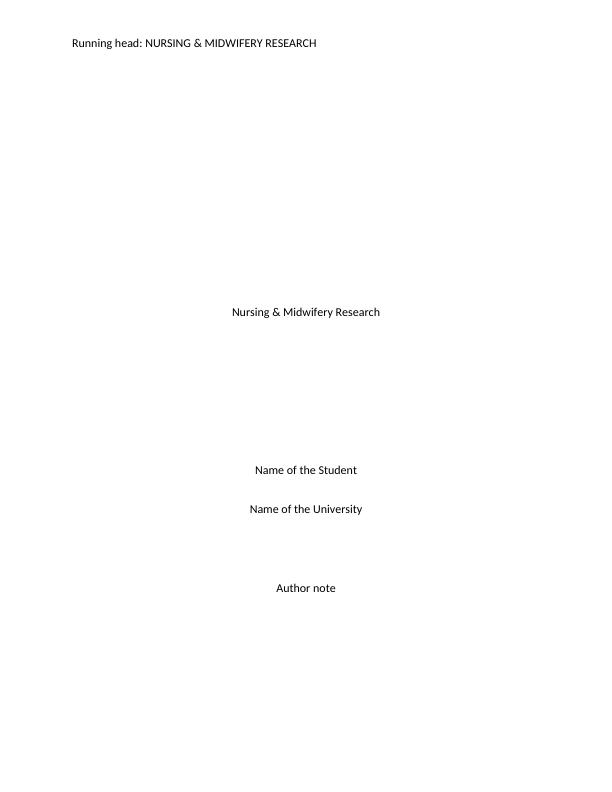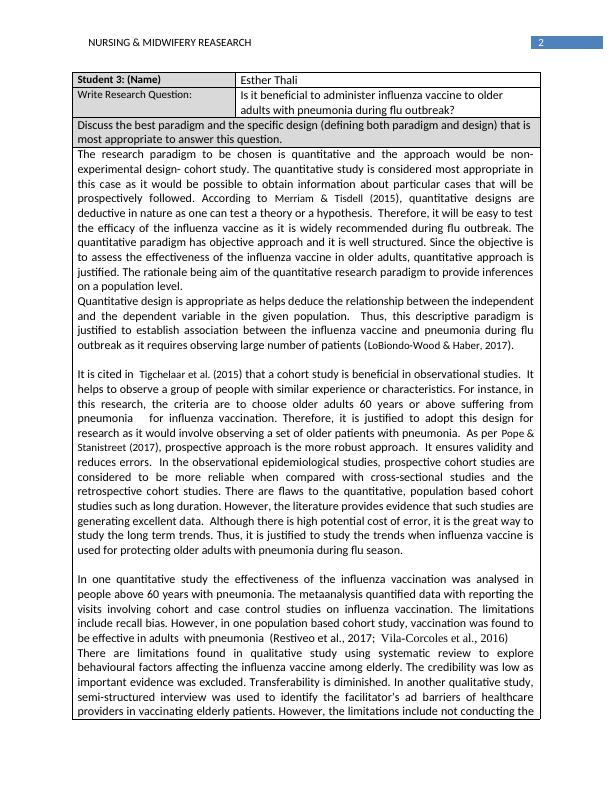(PDF) Nursing and Midwifery Research.
Added on 2021-04-24
4 Pages993 Words27 Views
Running head: NURSING & MIDWIFERY RESEARCHNursing & Midwifery ResearchName of the StudentName of the UniversityAuthor note

2NURSING & MIDWIFERY REASEARCHStudent 3: (Name)Esther Thali Write Research Question:Is it beneficial to administer influenza vaccine to older adults with pneumonia during flu outbreak?Discuss the best paradigm and the specific design (defining both paradigm and design) that is most appropriate to answer this question.The research paradigm to be chosen is quantitative and the approach would be non-experimental design- cohort study. The quantitative study is considered most appropriate inthis case as it would be possible to obtain information about particular cases that will beprospectively followed. According to Merriam & Tisdell (2015), quantitative designs aredeductive in nature as one can test a theory or a hypothesis. Therefore, it will be easy to testthe efficacy of the influenza vaccine as it is widely recommended during flu outbreak. Thequantitative paradigm has objective approach and it is well structured. Since the objective isto assess the effectiveness of the influenza vaccine in older adults, quantitative approach isjustified. The rationale being aim of the quantitative research paradigm to provide inferenceson a population level. Quantitative design is appropriate as helps deduce the relationship between the independentand the dependent variable in the given population. Thus, this descriptive paradigm isjustified to establish association between the influenza vaccine and pneumonia during fluoutbreak as it requires observing large number of patients (LoBiondo-Wood & Haber, 2017). It is cited in Tigchelaar et al. (2015) that a cohort study is beneficial in observational studies. Ithelps to observe a group of people with similar experience or characteristics. For instance, inthis research, the criteria are to choose older adults 60 years or above suffering frompneumonia for influenza vaccination. Therefore, it is justified to adopt this design forresearch as it would involve observing a set of older patients with pneumonia. As per Pope &Stanistreet (2017), prospective approach is the more robust approach. It ensures validity andreduces errors. In the observational epidemiological studies, prospective cohort studiesareconsidered to be more reliable when compared with cross-sectional studies and theretrospective cohort studies. There are flaws to the quantitative, population based cohortstudies such as long duration. However, the literature provides evidence that such studies aregenerating excellent data. Although there is high potential cost of error, it is the great way tostudy the long term trends. Thus, it is justified to study the trends when influenza vaccine isused for protecting older adults with pneumonia during flu season. In one quantitative study the effectiveness of the influenza vaccination was analysed inpeople above 60 years with pneumonia. The metaanalysis quantified data with reporting thevisits involving cohort and case control studies on influenza vaccination. The limitationsinclude recall bias. However, in one population based cohort study, vaccination was found tobe effective in adults with pneumonia (Restiveo et al., 2017; Vila-Corcoles et al., 2016)There are limitations found in qualitative study using systematic review to explorebehavioural factors affecting the influenza vaccine among elderly. The credibility was low asimportant evidence was excluded. Transferability is diminished. In another qualitative study,semi-structured interview was used to identify the facilitator’s ad barriers of healthcareproviders in vaccinating elderly patients. However, the limitations include not conducting the

End of preview
Want to access all the pages? Upload your documents or become a member.
Related Documents
Effect of Influenza Vaccine on Contracting Pneumonia in Older Adultslg...
|15
|1008
|378
Proposed Research Question.lg...
|2
|482
|36
Prospective epidemiological research studieslg...
|16
|2984
|20
